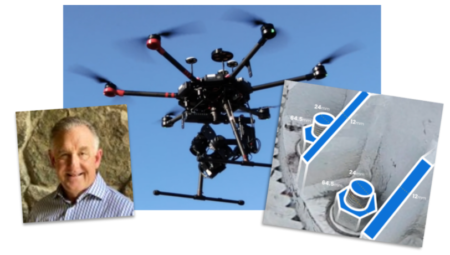Coming down from the heights of founding one of the world’s most successful towercos, Crown Castle, Ted Miller’s journey since his departure in 2002 has had an upward trajectory. Following his exit from the “C-Suite,” Miller, who studied Crown’s aerial mapping system which was used as a tool for new tower sites, acquired Visual Intelligence (VI), a company that provided aerial mapping services out of airplanes and helicopters.
Fast forward to today and Miller’s company is focused, literally, on collecting and disbursing state-of-the-art visual data on tower sites via drone technology. Recently, VI launched a new platform for drones, OpenTower® iQ, with Bentley Systems (BSY) that can read a tower like a book, right down to the last millimeter, including rust on loose-fitting bolts. With the precision of the data, however, the applications for it expand far beyond inspection grade info. The fidelity of the drone-collected output means the data has an impact on reducing CAPEX and OPEX costs, leasing capacity, personnel deployment and safety, equipment validation, portfolio capacity and valuations for mergers and acquisitions.
The system’s key hardware is a new, patented sensor that can capture millimeter data…as opposed to the off-the-shelf centimeter caliber type. But that was only half of the equation.
Miller’s team needed software that could interpret engineering-grade data and translate it into previously unseen insights and new forms of automation. Enter Bentley Acceleration Initiatives, an international infrastructure engineering software company who was attracted by the accuracy and resolution of the tower data produced by Miller’s company. VI has recently partnered with Bentley to develop and exclusively offer OpenTower® iQ. The collaboration allows a customer to have end-to-end service from data collection to inspection and engineering analysis, which, according to Miller, no other sensor system is able to provide. “Off-the-shelf drones provide data that allows inspection and very rough point clouds,” he said, “but engineers cannot use these rough point clouds to perform analytics.”
“Nothing relative to the management of communications infrastructure has changed in the last 25 years,” Miller said, “and whatever savings could be had from manual processes has long since been realized. It is time for the communications infrastructure business to digitize in order to realize a step function in enterprise level savings.”
“Those who do not digitize will continue to operate inefficiently in the new world of digitization and eventually be forced by the market and/or their investors in order to be able to compete financially. There is a clear advantage,” Miller said, “to knowing your real-time tower portfolio capacity, equipment and condition, and early adopters will have a significant advantage when streamlining operations or evaluating M&A opportunities. And, as we look at the cost and economics of rolling out 5G, companies who don’t find new ways of operating will see profits erode relative to their competition”.
With the reduction in site visits and actual climbs, Miller was quick to point out that his system does not sentence the tower tech to a new vocation. One of the goals of OpenTower iQ is to eliminate unnecessary climbs.
“It is common knowledge that competent tower climbers are a shrinking workforce,” Miller said, “However, this technology will not replace tower climbers, but rather make them more efficient for maintenance, repairs, upgrades, antenna placements and the like by allowing precise provisioning when a truck does roll. Why not collect once,” he said, “and avoid having to subsequently roll trucks and climb the tower in order to perform engineering?”
“The key,” Miller said, “is understanding what you have.”
For more information on OpenTower® iQ, click here.
By Jim Fryer, Inside Towers Managing Editor





Reader Interactions